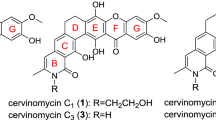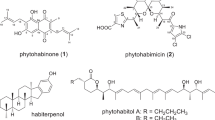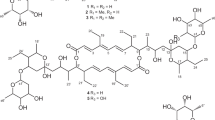Abstract
Four novel cyclic enaminones, designated RD4123A−D (1−4), and a new 4-quinazolinone metabolite, RD4123E (5), were isolated from the culture extract of an unidentified actinomycete strain RD004123, which belongs to the family Micromonosporaceae. Structures of 1−5 were determined by spectroscopic analyses using NMR, MS, and electronic circular dichroism (ECD), combined with quantum chemical calculations of ECD and NMR chemical shifts and biosynthetic consideration. Compounds 1−5 showed weak to modest cytotoxicity against murine leukemia P388 cells, while being inactive against bacteria and fungi.
This is a preview of subscription content, access via your institution
Access options
Subscribe to this journal
Receive 12 print issues and online access
$259.00 per year
only $21.58 per issue
Buy this article
- Purchase on Springer Link
- Instant access to full article PDF
Prices may be subject to local taxes which are calculated during checkout






Similar content being viewed by others
References
Newman DJ, Cragg GM. Natural products as sources of new drugs from 1981 to 2014. J Nat Prod. 2016;79:629–61.
Bérdy J. Bioactive microbial metabolites. J Antibiot. 2005;58:1–26.
Watve MG, Tichoo R, Jog MM, Bhole B. How many antibiotics are produced by the genus Streptomyces? Arch Microbiol. 2001;176:386–90.
Dictionary of Natural Products 29.2 Chemical Search. https://dnp.chemnetbase.com/faces/chemical/ChemicalSearch.xhtml (accessed September, 2021).
Parte AC, Sardà Carbasse,J Meier-Kolthoff JP, Reimer LC, Göker, M List of Prokaryotic names with Standing in Nomenclature (LPSN) moves to the DSMZ. Int. J. Syst. Evol. Microbiol. 2020; 70:5607-12 List of prokaryotic names with standing in nomenclature. http://www.bacterio.net (accessed September 21, 2021).
List of available RD strains on domestically derived strains. https://www.nite.go.jp/nbrc/cultures/rd/available_rd_list.html (Accessed November, 2021).
Wang X, Jia F, Liu C, Zhao J, Wang L, Shen Y, et al. Xiangella phaseoli gen. nov., sp. nov., a member of the family Micromonosporaceae. Int J Syst Evol Microbiol. 2013;63:2138–45.
Nouioui I, Carro L, García-López M, Meier-Kolthoff JP, Woyke T, Kyrpides NC, et al. Genome-based taxonomic classification of the phylum Actinobacteria. Front Microbiol. 2018;9:2007.
Lv M, Zhao J, Deng Z, Yu Y. Characterization of the biosynthetic gene cluster for benzoxazole antibiotics a33853 reveals unusual assembly logic. Chem Biol. 2015;22:1313–24.
Song H, Rao C, Deng Z, Yu Y, Naismith JH. The biosynthesis of the benzoxazole in nataxazole proceeds via an unstable ester and has synthetic utility. Angew Chem Int Ed. 2020;59:6054–61.
Martin GE, Hadden CE. Long-range 1H−15N heteronuclear shift correlation at natural abundance. J Nat Prod. 2000;63:543–85.
Noble M, Noble D, Sykes RB. G7063-2, a new nitrogen-containing antibiotic of the epoxydon group, isolated from the fermentation broth of a species of Streptomyces. J Antibiot. 1977;30:455–9.
Reddy GCS, Sood RS, Nadkarni SR, Reden J, Ganguli BN, Fehlhaber HW, et al. Stereochemistry of the epoxydon group antibiotic G7063-2 isolated from a Streptomyces species hpl y-25711. J Antibiot. 1984;37:1596–9.
Itoh Y, Haneishi T, Arai M, Hata T, Aiba K, Tamura C. New antibiotics, enaminomycins A, B and C. J Antibiot. 1978;31:838–46.
Orezzi GP, Arlandini E, Ballabio M, Cassinelli G, Di Matteo E, Garofano ML, et al. Epoxydon-like antibiotics. Kangshengsu. 1986;11:474–84.
Glaus MA, Heijman CG, Schwarzenbach RP, Zeyer J. Reduction of nitroaromatic compounds mediated by Streptomyces sp. exudates. J Appl Environ Microbiol. 1992;58:1945–51.
Spiteller P, Steglich W. Blennione, a green aminobenzoquinone derivative from Lactarius blennius. J Nat Prod. 2002;65:725–7.
Zhang X, Shu C, Li Q, Lian X-Y, Zhang Z. Novel cyclohexene and benzamide derivatives from marine-associated Streptomyces sp. ZZ502. Nat Prod Res. 2019;33:2151–9.
Wiley PF, Mizsak SA, Baczynskyj L, Argoudelis AD, Duchamp DJ, Watt W, et al. The structure and chemistry of paulomycin. J Org Chem. 1986;51:2493–9.
González A, Rodríguez M, Braña AF, Méndez C, Salas JA, Olano C, et al. New insights into paulomycin biosynthesis pathway in Streptomyces albus J1074 and generation of novel derivatives by combinatorial biosynthesis. Microb Cell Fact. 2016;15:56.
Sarmiento-Vizcaíno A, Braña AF, Pérez-Victoria I, Martín J, De Pedro N, Cruz M, et al. Paulomycin G, a new natural product with cytotoxic activity against tumor cell lines produced by deep-sea sediment derived Micromonospora matsumotoense M-412 from the Avilés Canyon in the Cantabrian Sea. Mar Drugs. 2017;15:271.
Hoz JF, Méndez C, Salas JA, Olano C. bioactive paulomycin derivatives produced by Streptomyces albus J1074. Molecules. 2017;22:1758.
Gomes PB, Nett M, Dahse H-M, Hertweck C. Pitucamycin: structural merger of a phenoxazinone with an epoxyquinone antibiotic. J Nat Prod. 2010;73:1461–4.
Nett M, Hertweck C. Farinamycin, a quinazoline from Streptomyces griseus. J Nat Prod. 2011;74:2265–8.
Wahan SK, Sharma B, Chawla PA. Medicinal perspective of quinazolinone derivatives: recent developments and structure–activity relationship studies. J Heterocycl Chem. 2021;59:239–57.
Shang X-F, Morris-Natschke SL, Liu Y-Q, Guo X, Xu X-S, Goto M, et al. Biologically active quinoline and quinazoline alkaloids part I. Med Res Rev. 2018;38:775–828.
Shang X-F, Morris-Natschke SL, Yang G-Z, Liu Y-Q, Guo X, Goto M, et al. Biologically active quinoline and quinazoline alkaloids part II. Med Res Rev. 2018;38:1614–60.
Maskey RP, Shaaban M, Grün-Wollny I, Laatsch H. Quinazolin-4-one derivatives from Streptomyces isolates. J Nat Prod. 2004;67:1131–4.
Chen G, Gao H, Tang J, Huang Y, Chen Y, Wang Y, et al. Benzamides and quinazolines from a mangrove actinomycetes Streptomyces sp. (No. 061316) and their inhibiting caspase-3 catalytic activity in vitro. Chem Pharm Bull. 2011;59:447–51.
Xue JH, Xu LX, Jiang Z-H, Wei X. Quinazoline alkaloids from Streptomyces michiganensis. Chem Nat Compd. 2012;48:839–41.
Kornsakulkarn J, Saepua S, Srijomthong K, Rachtawee P, Thongpanchang C. Quinazolinone alkaloids from actinomycete Streptomyces sp. BCC 21795. Phytochem Lett. 2015;12:6–8.
Boonlarppradab C, Suriyachadkun C, Supothina S, Laksanacharoen P. Amethysione and amethysamide, new metabolites from Streptosporangium amethystogenes BCC 27081. J Antibiot. 2016;69:459–63.
Wu X, Liu Y, Sheng W, Sun J, Qin G. Chemical constituents of Isatis indigotica. Planta Med. 1997;63:55–57.
MacroModel; Schrödinger, LLC: New York, NY, USA, 2019.
Gaussian 16, Revision B.01; Gaussian, Inc.: Wallingford, CT, USA, 2016.
Karim MRU, Harunari E, Oku N, Akasaka K, Igarashi Y. Bulbimidazoles A–C, antimicrobial and cytotoxic alkanoyl imidazoles from a marine gammaproteobacterium Microbulbifer species. J Nat Prod. 2020;83:1295–12.
Acknowledgements
The authors are in debt to Dr. Moriyuki Hamada at Biological Resource Center, National Institute of Technology and Evaluation (NBRC), Chiba, Japan, for acquiring the SEM image, and Prof. Y. Hikichi and Dr. A. Kanda at Kochi University for providing R. solanacearum SUPP1541. This work was supported by JSPS KAKENHI Grant Number 19K05848 to Y.I.. P388 cells were obtained from JCRB Cell Bank under an accession code JCRB0017 (Lot. 06252002).
Author information
Authors and Affiliations
Corresponding author
Ethics declarations
Conflict of interest
The authors declare no competing interests.
Additional information
Publisher’s note Springer Nature remains neutral with regard to jurisdictional claims in published maps and institutional affiliations.
Supplementary information
Rights and permissions
Springer Nature or its licensor holds exclusive rights to this article under a publishing agreement with the author(s) or other rightsholder(s); author self-archiving of the accepted manuscript version of this article is solely governed by the terms of such publishing agreement and applicable law.
About this article
Cite this article
Triningsih, D.W., Zhou, T., Fukaya, K. et al. Cyclic enaminones and a 4-quinazolinone from an unidentified actinomycete of the family Micromonosporaceae. J Antibiot 75, 610–618 (2022). https://doi.org/10.1038/s41429-022-00558-y
Received:
Revised:
Accepted:
Published:
Issue Date:
DOI: https://doi.org/10.1038/s41429-022-00558-y
This article is cited by
-
Development of a drug discovery approach from microbes with a special focus on isolation sources and taxonomy
The Journal of Antibiotics (2023)



